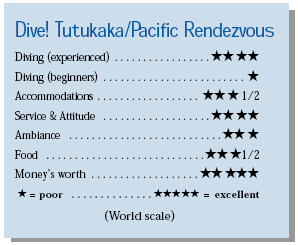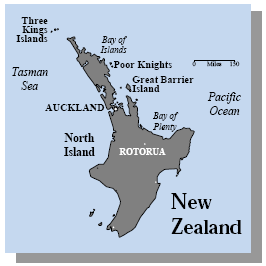Diving the Poor KnightsContents of this Issue: $31 Million Verdict for Paralyzed Diver Travel Insurers Contacts and Rates Divers Witness Mexican Carnage Editorial Office: Ben Davison Publisher and Editor Undercurrent 3020 Bridgeway, Suite 102 Sausalito, CA 94965 Getting Maomao’ed in New Zealand from the July, 2000 issue of Undercurrent
For any diver going to the South Pacific, New Zealand ought to be on the itinerary. For one, Air New Zealand offers inexpensive stopovers on its flights from the U.S., so an itinerary that includes Auckland and then Fiji, Tonga, the Cook Islands, or other stops is only a few bucks more. Second, it’s an interesting country, and when one leaves Auckland and, say, heads north, the calendar seems to turn back a few decades. Third, a two-to-one Kiwi to US Dollar exchange rate and a rigorous national anti-tipping attitude make it economically attractive -- a greenback goes a long way here. Finally, there’s some awfully interesting diving, clearly unique by any standards. One of our well-traveled reviewers will tell you about it. **************************** I’ve been diving 44 years, and my bones store hours of chill in northern California waters that today are only too often barren. Now warm water is usually where I head, but this trip I’d become so intrigued with what I’d read about someplace cooler -- the Poor Knights Islands, off New Zealand’s North Island's eastern shore -- that I packed my 5mm wetsuit suit and a hooded vest to “give it a go” as a stopover on a tropical South Pacific trip. The drive from Auckland to tiny Tutukaka, less than three hours by rental car, takes one past the northern ‘burbs and shores on scenic two-lane roads winding through bucolic hills and green pastures, lined with colorful pohutukawa trees and giant ferns -- even wineries where one is welcome to browse or stop for lunch. A couple of small towns and one small city, Whangarei (Kiwis pronounce it “fan-guhray”) are stop-offs for dive gear, food and other purchases, including film development. Tutukaka itself is a small town on a protected bay, with settlements and homes spread out in the hills and shore sides. The marina is by far the largest activity in the area and the site of the restaurants and small general store/petrol station. Some Kiwis live in this paradise, many vacation here. I was in New Zealand ten days, five of them spent in Tutukaka’s Pacific Rendezvous,
a couple of miles from Tutukaka proper. The hotel sits on spacious grounds on a
green, tree-studded promontory overlooking
the Pacific Ocean, with distant views of
the Poor Knights Islands. While I prepared my own breakfast and lunched on the boat, dinner gave me a chance to sample several local restaurants. Whangarei Deep Sea Anglers’ Club welcomes visitors, but seemed stuffy and overpriced, with impersonal service and zero ambiance. My preference by far was the quirky-looking many-roomed “Schnappa Rocks” across from the marina, next to Dive! Tutukaka. Food there was imaginative and well prepared, service enthusiastic, ambiance warm and relaxing. Starters included such items as whole shell mussels steamed open with a touch of red Thai curry, coconut, and coriander. Delicious mains included Pacific pork fillet basted in garlic served on curried taro and sweet potato in green banana chutney, or oven-baked chicken breast, herb crusted, with tri-colored fettuccine, eggplant relish, and roast bell pepper cream sauce. Starters averaged US$5, mains around $10. I bought and took my own wine, paying US 50 cents per drinker for glasses and corkage. The local dive op, Dive! Tutukaka, is a coalition of three dive operations that decided to compete with other destinations instead of each other. Their garish shop, stucco-covered to resemble an Alp, looked like the entrance to a cheap amusement park ride. In the conventional interior they offered gear for sale and rent, racks of “hire” wetsuits, and tee shirts. A staffer handed me a waiver, looked over my c-card and log, and told me to store my gear under the seats on the 42-foot El Tigre for 8:30 a.m. departure. El Tigre’s spacious dive deck offered bench areas for 16 and would get crowded with a full load of 26 pax and crew. There was a warm cabin for dry guests, two heads (one topside for damp divers), a small foc’sl with berths, and a small galley. Camera gear can be secured, and rinse is provided. Boats are completely equipped with O2, radio, and full safety gear. As the boat began to swell with a small crowd of divers and a few snorkelers, so did my disappointment. I’d been low-balled, loaded on a cattle boat! Some of my fellow passengers were actually doing certification dives, others were novices, and a few were experienced divers from Europe, Asia, Canada, and the USA. There was even a family with children, along for snorkeling! Ah, well, Jacques Cousteau raved about the diving here, the crew seemed friendly enough, and our fellow passengers were getting along -- a cattle dive is better than no dive at all.
Selecting the dive site required some judicious eyeballing of the varying weather and currents, but this little archipelago has many harbors and caverns for divers. Once moored at the stony baylet -- named Maomao Arch for its cavern -- they gave us a thorough briefing. Novices were paired up and assigned guides, snorkelers departed, a couple of kayaks were launched, and required buddy pairs strode off the rear platform. The water was cool -- 67° at the surface -- with mild thermoclines on our way down the sheer rock slopes (to 300 fsw). I adjusted my eyes in the 60' vis to the bouldery bottom, covered with kelp and abounding with fish I’d not seen before. A foot-long black banded male Sandager’s wrasse came out to meet me while a couple of arm-length snapper wandered unconcernedly and a school of two-foot trevally gently streamed by -- all the result of newly won complete protection. A large school of hand-sized blue maomao, scales sparkling in the shafts of sunlight, headed toward a large stony tube penetrating through to the neighboring bay. Navigation was easy in this stony bowl we were in, with the sun a bright beacon above. Some northern splendid perch schooled by, males pink with mauve, as gaudy as any school of anthias -- but 8–10 inches long! “Crays” or lobsters were common. Dr. Cousteau was right -- good diving, with reassuringly large numbers of fish. I followed my warm shower on the dive platform with the sack lunch I had prepared at the general store in Tutukaka (lunch is strictly BYO), accompanied by hot soups served by the crew. After the requisite story trading and surface time, Capt. Glenn -- who once operated a live-aboard to the distant northern Kermadec Islands -- took us past stunning islands and through a couple of larger arches. We entered a large hole in the side of one island, a huge underground dome (Ricorico Cave), its placid waters barely illuminated by the distant sun. A favored dive spot, the captain said the low light brings giant lobsters, varied morays and swarms of life normally found considerably deeper. The El Tigre usually returned about 4:00 PM after a two-dive day. The balance of the time was spent in transit, 1.5 hour surface intervals, extensive moving around to find the next site (necessitated by weather and wind conditions), and just plain sightseeing! What started out feeling like a cattle dive due to the numbers and mixed abilities of divers turned out to be a unique blend of efficient “silent service” by the very busy staff, great sightseeing, and excellent diving. At Blue Maomao Arch, we anchored between a couple of islands. Here was more life in cracks and crevices than I ever spotted before -- and different life at that. I dropped in and followed my compass to the channel between the submerged boulder and cavern floor as per the briefing. The rocky bottom was carpeted with gently waving fronds of kelp, and lizardfish reminded me warm water actually made it here. Stately stingrays (3' on average, but reaching 12') gathered to breed during the February and March summer season. Great schools of blue maomao even use the boat shadow as gathering beacons. Swimming through the channel between the huge rock and the cavern floor, I entered a spacious boulder-strewn stone walled tube of subway tunnel proportions that penetrated the island’s promontory. A large hole in the cavern’s side allowed a shimmering curtain of light to make dappled designs in the gloom, making the interior resemble a medieval cathedral, with orange cup corals and colonies of pink jewel anemones, growing with golden sponges, weaving a colorful tapestry on the walls. As I became used to the subdued light, the denizens of this twilight world began to stand out. The most obvious was the never-ending stream of bluish twinspot damsels, a literal river of 4-inch fish flowing past me, so dense I couldn’t see the wall. A 18-inch bright red pigfish with a slash of brilliant yellow followed me around like a forlorn puppy dog. Foot-long northern scorpionfish cradled in cracks between the boulders, bright red in the beam of my torch. A white-spotted orange toadstool grouper rested in the cracks, tilting like a drunk fish resting on his way home. Rare butterflyfish kept their distance, a pair of black angelfish cruised by, and yellow morays came out to greet me, resting their chins in an outstretched hand before gently undulating away. Poor Knights colors and fish don’t take a back seat to even really good tropical diving! As I dropped down to the rocky bottom, googly-eyed blue-eyed 2-inch triplefins looked up at me appealingly, just like they did from a recent Ocean Realm cover. My “torch” beam revealed jewel-encrusted nudibranchs and diadema sea urchins whose weird eye-like waste sacs glowed blood-red. This is no place to be caught without a camera or videocam! I had to ask myself time and again: wasn’t this really some sort of neotropical paradise? No, this was the Poor Knights Islands, in temperate New Zealand, in March, their summer’s end...a worthy dive destination, full of excitement and densely packed life. The most experienced diver won’t feel jaded here, and a novice will be spoiled by the treat of diving pristine temperate waters. Poor Knights is an example of what can happen when we truly preserve marine areas. -L.J.
|

I want to get all the stories! Tell me how I can become an Undercurrent Online Member and get online access to all the articles of Undercurrent as well as thousands of first hand reports on dive operations world-wide
| Home | Online Members Area | My Account |
Login
|
Join
|
| Travel Index |
Dive Resort & Liveaboard Reviews
|
Featured Reports
|
Recent
Issues
|
Back Issues
|
|
Dive Gear
Index
|
Health/Safety Index
|
Environment & Misc.
Index
|
Seasonal Planner
|
Blogs
|
Free Articles
|
Book Picks
|
News
|
|
Special Offers
|
RSS
|
FAQ
|
About Us
|
Contact Us
|
Links
|
3020 Bridgeway, Ste 102, Sausalito, Ca 94965
All rights reserved.

 Condo-like apartments
and chalets range from one to three
bedrooms, fully furnished with appliances,
TV, and utensils. There’s also a pleasant
pool, small shop for breakfast fixin’s and
incidentals, barbecue areas, guest laundry,
tennis courts, and two private beaches.
Prices are US$65 - 80 a night, and the
setting is stunning.
Condo-like apartments
and chalets range from one to three
bedrooms, fully furnished with appliances,
TV, and utensils. There’s also a pleasant
pool, small shop for breakfast fixin’s and
incidentals, barbecue areas, guest laundry,
tennis courts, and two private beaches.
Prices are US$65 - 80 a night, and the
setting is stunning. The scenic 15-mile, hour-plus trip left the
California-like Tutukaka coast behind us as we
steamed toward the jagged lava forms of the Poor
Knights Islands. Along the way, I spotted dolphins
and even molas, those giant ocean sunfish. Soon, the
quiet and competent Capt. Glenn Edney, a slender,
intense, sandy-haired man who was very committed to
diving, was asking me about my experience and comfort
levels (as the crew did with each passenger),
whether I wanted guiding, and other questions that
made me take back my first impressions. With lots of
experience in the dive business, Glenn wants to
share the environment with everyone, and he’s a
respected u/w photographer to boot. Divemasters
Richard and Dave were a quiet and generally very
busy lot, what with the crowds and working with
novices and students. Jeannine, however, was a standout. An enthusiastic young
woman, she was helpful, gregarious, and an excellent fish spotter. At day’s end this
no-nonsense staff lugged, rinsed, dried, and stored my gear for the next day’s diving.
The scenic 15-mile, hour-plus trip left the
California-like Tutukaka coast behind us as we
steamed toward the jagged lava forms of the Poor
Knights Islands. Along the way, I spotted dolphins
and even molas, those giant ocean sunfish. Soon, the
quiet and competent Capt. Glenn Edney, a slender,
intense, sandy-haired man who was very committed to
diving, was asking me about my experience and comfort
levels (as the crew did with each passenger),
whether I wanted guiding, and other questions that
made me take back my first impressions. With lots of
experience in the dive business, Glenn wants to
share the environment with everyone, and he’s a
respected u/w photographer to boot. Divemasters
Richard and Dave were a quiet and generally very
busy lot, what with the crowds and working with
novices and students. Jeannine, however, was a standout. An enthusiastic young
woman, she was helpful, gregarious, and an excellent fish spotter. At day’s end this
no-nonsense staff lugged, rinsed, dried, and stored my gear for the next day’s diving. Diver’s Compass: Dive! Tutukaka: +64-9-4343-867, fax –884;
e-mail
Diver’s Compass: Dive! Tutukaka: +64-9-4343-867, fax –884;
e-mail 